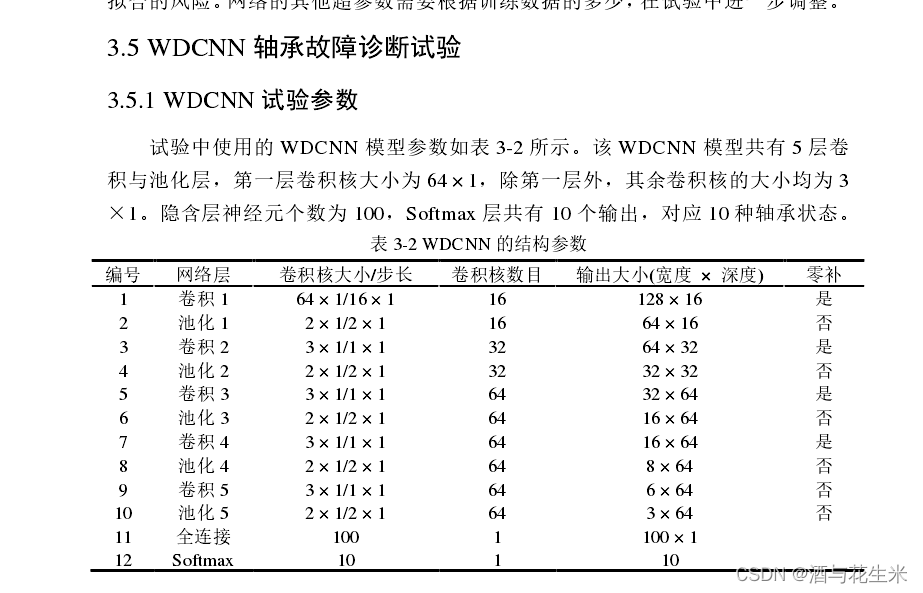热门标签
热门文章
- 1反向传播算法(Backpropagation)----Gradient Descent的推导过程_gradient 反向传播
- 2docker安装ollama_docker 如何安装ollama容器
- 3python3.8搭建Keras +TensorFlow环境_python3.8安装tensorflow,keras的版本
- 4最长回文子序列_最长回文子序列 c++给定一个字符串s,找到其中最长的回文子序列,并返回该序列的长
- 5Java-常用API-2
- 6为什么Redis单线程却比多线程快_单线程为什么比多线程快
- 7Journal of Electronic Imaging(JEI)从投稿到录用过程分享
- 8使用Python进行自动化测试Selenium与PyTest的结合_使用 pytest-xdist 结合 selenium-grid 实现自动化用例分布式并发执行示例
- 9蓝桥杯集训·每日一题 AcWing 3729. 改变数组元素(差分)_acwing3729 题java解法
- 10Vue3 官方文档速通_vue3.0官方文档
当前位置: article > 正文
轴承故障诊断经典模型pytorch复现(一)——WDCNN
作者:盐析白兔 | 2024-04-13 02:47:19
赞
踩
wdcnn
论文地址:《A New Deep Learning Model for Fault Diagnosis with Good Anti-Noise and Domain Adaptation Ability on Raw Vibration Signals》—张伟
我们要复现的论文是轴承故障诊断里比较经典的一个模型WDCNN,最近在看的很多论文都把WDCNN作为比较模型,但是只找到过tensorflow版本的源码且只有原始的WDCNN没有改进的WDCNN-AdaBN版本,而我自己又是用的pytorch,因此就打算自己复现一下。话不多说直接上代码。
WDCNN:

#!/usr/bin/python
# -*- coding:utf-8 -*-
import torch
from torch import nn
import warnings
# ----------------------------inputsize >=28-------------------------------------------------------------------------
class WDCNN(nn.Module):
def __init__(self, in_channel=1, out_channel=10):
super(WDCNN, self).__init__()
self.layer1 = nn.Sequential(
nn.Conv1d(in_channel, 16, kernel_size=64,stride=16,padding=24),
nn.BatchNorm1d(16),
nn.ReLU(inplace=True),
nn.MaxPool1d(kernel_size=2,stride=2)
)
self.layer2 = nn.Sequential(
nn.Conv1d(16, 32, kernel_size=3,padding=1),
nn.BatchNorm1d(32),
nn.ReLU(inplace=True),
nn.MaxPool1d(kernel_size=2, stride=2))
self.layer3 = nn.Sequential(
nn.Conv1d(32, 64, kernel_size=3,padding=1),
nn.BatchNorm1d(64),
nn.ReLU(inplace=True),
nn.MaxPool1d(kernel_size=2, stride=2)
) # 32, 12,12 (24-2) /2 +1
self.layer4 = nn.Sequential(
nn.Conv1d(64, 64, kernel_size=3,padding=1),
nn.BatchNorm1d(64),
nn.ReLU(inplace=True),
nn.MaxPool1d(kernel_size=2, stride=2)
) # 32, 12,12 (24-2) /2 +1
self.layer5 = nn.Sequential(
nn.Conv1d(64, 64, kernel_size=3),
nn.BatchNorm1d(64),
nn.ReLU(inplace=True),
nn.MaxPool1d(kernel_size=2, stride=2)
# nn.AdaptiveMaxPool1d(4)
) # 32, 12,12 (24-2) /2 +1
self.fc=nn.Sequential(
nn.Linear(192, 100),
nn.ReLU(inplace=True),
nn.Linear(100, out_channel)
)
def forward(self, x):
# print(x.shape)
x = self.layer1(x) #[16 64]
# print(x.shape)
x = self.layer2(x) #[32 124]
# print(x.shape)
x = self.layer3(x)#[64 61]
# print(x.shape)
x = self.layer4(x)#[64 29]
# print(x.shape)
x = self.layer5(x)#[64 13]
# print(x.shape)
x = x.view(x.size(0), -1)
x = self.fc(x)
return x
- 1
- 2
- 3
- 4
- 5
- 6
- 7
- 8
- 9
- 10
- 11
- 12
- 13
- 14
- 15
- 16
- 17
- 18
- 19
- 20
- 21
- 22
- 23
- 24
- 25
- 26
- 27
- 28
- 29
- 30
- 31
- 32
- 33
- 34
- 35
- 36
- 37
- 38
- 39
- 40
- 41
- 42
- 43
- 44
- 45
- 46
- 47
- 48
- 49
- 50
- 51
- 52
- 53
- 54
- 55
- 56
- 57
- 58
- 59
- 60
- 61
- 62
- 63
- 64
- 65
- 66
- 67
- 68
- 69
- 70
- 71
- 72
WDCNN在CWRU数据集上的表现,效果相当的好嘛。




声明:本文内容由网友自发贡献,不代表【wpsshop博客】立场,版权归原作者所有,本站不承担相应法律责任。如您发现有侵权的内容,请联系我们。转载请注明出处:https://www.wpsshop.cn/w/盐析白兔/article/detail/413990
推荐阅读
相关标签


